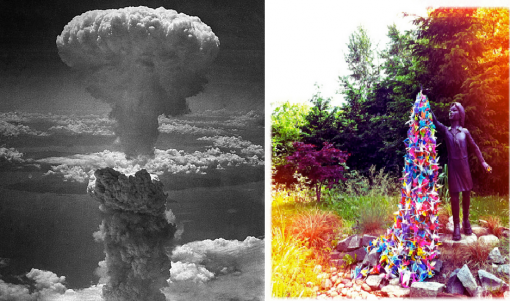
Today, 6th of August 2018, marks 73 years since the United States dropped a nuclear bomb on Hiroshima. After the unsuccessful “Fat Man” and “Thin Man” bombs, Little Boy was developed at the Manhattan Project with Robert Oppenheimer at its helm. Little Boy, as we now know, wasn’t very little after all. It left 1,35,000 bodies in its wake. Survivors talk about the three-fold effect of the blast – first, the destruction caused by the explosion, then the heat and finally the radiation. Scientists are still debating the lingering effects of the radiation caused by the nuclear bomb explosion.
In 2017, a nuclear disarmament treaty was adopted by a UN conference that “prohibits a full range of nuclear-weapons-related activities, such as undertaking to develop, test, produce, manipulate, acquire, possess or stockpile nuclear weapons or other nuclear devices, as well as the use or threat of use of these weapons” Five countries voted against – the United States, Russia, North Korea, United Kingdom and France – while three countries abstained – India, China, and Pakistan. Though the Indian government issued a statement supporting the idea of disarmament, there is yet any real action to be seen on it.
There are many peace building and peace keeping ventures that have come out of the horrific incident. Peace Minds Hiroshima, led by Tomiko Kawano, spreads the message of peace and the story of Sadako Sasaki, who died 10 years after the blast of cancer caused by the radiation. On her hospital bed folding a thousand paper cranes and hoping she would recover. Every year Peace Minds Hiroshima receives 10 million paper cranes – 10 metric tonnes which are more than the weight of Hiroshima and Nagasaki atom bombs combined–, which they recycle and make notebooks out of and distribute to children overseas.
“The atomic bomb must never be used again,” says one of the survivors, hibakusha as they are referred to in Japanese, interviewed in the documentary Message from Hiroshima directed by Masaaki Tanabe with narration by George Takei. Psychological and economic damages to people are still being reckoned with. A study conducted in 1995 shows that 70,000 of the survivors show a very high incidence of depression.

Hiroshima has an urgent message for the whole world.
Hiroshima has an urgent message for us in India. Under the incumbent Indian government, war mongering has become the new normal. There is a rise in nationalist jingoism and with the current Government led by the BJP; India finds itself squarely in the middle of the nuclear issue.
There have been many anti-war campaigns in India. After the surgical strikes in 2016 along the India-Pakistan border, a protest was organised at the Jantar Mantar where several prominent speakers and cultural groups told our leaders “Make art, not war”.
Rabindranath Tagore wrote a short story titled Dhvangsa (Destruction), based on the Second World War. The story ends with the narrator reciting a poem on war.
Other writers too have contributed to the anti-war movement. Manash Firaq Bhattacharjee and Priya Sarukkai Chabaria’s poems are examples of this anti-war spirit.




